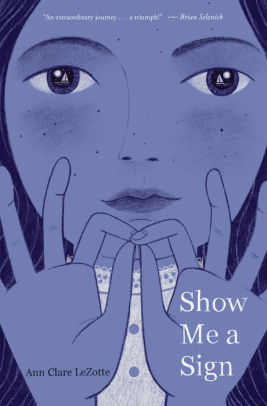Show Me a Sign explores a little-known chapter of American history from the perspective of a Deaf protagonist.
Show Me a Sign by Ann Clare LeZotte. Scholastic, 2020, 269 pages.

Reading Level: Middle Grades, 10-12
Recommended for : ages 12-15
Mary Lambert, now 11, was born Deaf but doesn’t experience deafness as a disability. That’s largely because she is not alone: on her home island of Martha’s Vineyard, in the Year of Our Lord 1805, many of her neighbors are Deaf. In her own family, Papa can’t hear, but Mama can, and so could George, Mary’s only sibling. George was killed only recently, in an accident that Mary feels responsible for. She’s told no one how it happened, and Mama’s grief exacerbates her guilt.
The arrival of Andrew Noble, a young man from Boston who fancies himself a scientist, introduces another strand of tension. Mr. Noble wants to study the Deaf population of the island to determine why there are so many. But it’s clear he has nothing but contempt for the Deaf, seeing them as not only disabled but subhuman. This can be dismissed as obnoxious ignorance, until his intentions take a sinister turn directed at Mary.
The first half of the novel is a bit slow, raising issues between White settlers and native Wampanoags, between Mary and her best friend, and between Mary and her mother. These aren’t resolved, or else are resolved too easily as the main plot becomes a rescue story. Still, Mary’s point of view is worth sharing, as her deafness is seen as an identity, not a disability, and no impediment to a full, productive life.
Overall Rating: 4 (out of 5)
- Worldview/moral value: 4
- Artistic/literary value: 4
Considerations:
- The clash of religious worldviews between Christianity and native tradition is illustrated by Mary and her friend Thomas, a freed slave who has embraced his Wampanoag wife’s religion. Their relationship shows how people can hold different convictions and still respect each other.
- Mary’s Christian faith seems genuine and her prayers in times of stress are both heartfelt and theologically sound.
- The charitable view of the past is unusual. Papa credits his own great-grandfather with courage and tenacity in coming to the New World but doesn’t excuse the dispossession of indigenous people. “We can’t hide from our ancestors’ misdeeds.” “But we can make our own choices now,” Mary affirms.
We are participants in the Amazon LLC affiliate program; purchases you make through affiliate links like the one below may earn us a commission.Read more here.
Also at Redeemed Reader:
- Brian Selznek’s Wonderstruck contrasts the experience of two Deaf characters living in different time periods.
- Popular graphic novelist Cece Bell won a Newbery honor for her memoir, El Deafo.
- A more recent book featuring a Deaf character: Song for a Whale.
Support our writers and help keep Redeemed Reader ad-free by joining the Redeemed Reader Fellowship.
Stay Up to Date!
Get the information you need to make wise choices about books for your children and teens.
Our weekly newsletter includes our latest reviews, related links from around the web, a featured book list, book trivia, and more. We never sell your information. You may unsubscribe at any time.
We'd love to hear from you!
Our comments are now limited to our members (both Silver and Golden Key). Members, you just need to log in with your normal log-in credentials!
Not a member yet? You can join the Silver Key ($2.99/month) for a free 2-week trial. Cancel at any time. Find out more about membership here.

